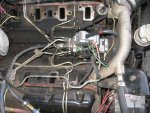zdubz
New member
- 27
- 0
- 1
- Location
- Boomtown, ND, USA
Just got an M1009 that has a faulty fuel gauge/needle. I noticed the needle fluctuating about a quarter gallon occasionally. For the last few days it has been stuck at a quarter tank. I put an extra 5 gallon jug of fuel in the back of the truck in-case I rant out, and of course, on a highway entrance I did. Within about 2-3 seconds after hearing it start to "Chug" and try to get fuel, I had it in neutral and killed the engine and was coasting to the shoulder.
I put the entire 5 gallons in the tank, and watched the fuel needle register a change of fluid level. Warmed the plugs, and tried to start and heard the most God awful grinding sound I've witnessed any vehicle make ever. Towed it home, pulled the starter, and it looks fine. It's brand new, there were almost no metal shavings at all, and the portion of the flywheel that I've been able to see thus far looked good as well. I'm going to try and rotate the flywheel and investigate the rest of the teeth as well.
The noise was definitely worse the first time I tried to start it, but still sounded bad when I tried a second time. I don't know all of the components that could produce or contribute to these noises, but it sounds to me like a mechanical "teeth on teeth" grinding/whining sort of resistance. It IS technically cranking I guess.. because the belt moves.. but it sounds terrible like I said, and of course is not turning over.
I've heard that if these fuel pumps are run dry for any amount of time they can seize up. I hope that is the only problem and that I haven't damaged anything in the interim. My game plan so far is check the rest of the flywheel teeth, replace the fuel pump, and then drive down to the Armory and see if Company B has a mechanic who knows about CUCVs. Other than that.. Any input is appreciated, thanks!
I put the entire 5 gallons in the tank, and watched the fuel needle register a change of fluid level. Warmed the plugs, and tried to start and heard the most God awful grinding sound I've witnessed any vehicle make ever. Towed it home, pulled the starter, and it looks fine. It's brand new, there were almost no metal shavings at all, and the portion of the flywheel that I've been able to see thus far looked good as well. I'm going to try and rotate the flywheel and investigate the rest of the teeth as well.
The noise was definitely worse the first time I tried to start it, but still sounded bad when I tried a second time. I don't know all of the components that could produce or contribute to these noises, but it sounds to me like a mechanical "teeth on teeth" grinding/whining sort of resistance. It IS technically cranking I guess.. because the belt moves.. but it sounds terrible like I said, and of course is not turning over.
I've heard that if these fuel pumps are run dry for any amount of time they can seize up. I hope that is the only problem and that I haven't damaged anything in the interim. My game plan so far is check the rest of the flywheel teeth, replace the fuel pump, and then drive down to the Armory and see if Company B has a mechanic who knows about CUCVs. Other than that.. Any input is appreciated, thanks!
Last edited:



